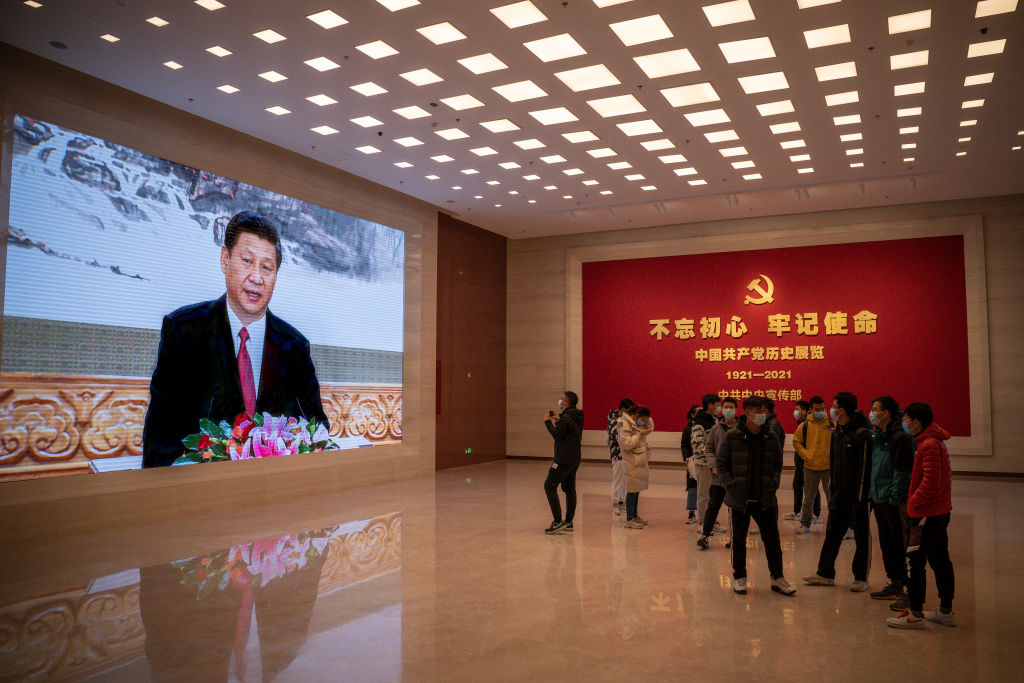Something smells like victory.
Saving America’s Future from the Blob

How to understand—and rectify—the foreign policy disaster of 2024.
Never believe what bipartisan foreign policy establishment hacks say about China and Russia. They don’t believe what they say, either. The Blob (as Obama aide Ben Rhodes called it) learned through generations of strategic blunders that if everyone closes ranks and sticks to the same story, its members will survive a strategic disaster of any magnitude with their careers intact. The same principle explains why not a single American banker went to jail after the subprime collapse of 2008, the biggest fraud in all financial history. The Blob’s logic is simple: If you go after one of us, then you have to go after all of us, and who will be left to put things back together?
Whether it was right for America to go abroad seeking monsters to destroy in Moscow and Beijing, the way we went about it was abominably stupid. “If an injury has to be done to a man it should be so severe that his vengeance need not be feared,” Machiavelli advised. Washington has wounded Russia and China but not disabled them, setting in motion a tragic sequence of responses that in the worst case will lead to war, but more likely will leave the United States with vastly diminished strategic standing.
The rise of China and the resilience of Russia have persisted through serried waves of tech restrictions, $125 billion of NATO support for Ukraine, and an unprecedented sanctions regime against Russia, including the seizure of $300 billion in reserves, among other measures.
The Black Legend propounded by the Blob states that China is on the verge of invading Taiwan because its Communist leaders hate democracy, and because it wants to distract its citizens from their economic misery. It claims that Vladimir Putin wants to revive the Russian Empire and invaded Ukraine because it “is a country that for decades has enjoyed freedom and democracy and the right to choose its own destiny.”
In fact China has bracing economic challenges, but no crisis, and no widespread popular discontent. It wants to preserve the status quo, barring a Taiwanese move toward sovereignty, which is all but ruled out by the results of Taiwan’s national elections this January. China is a formidable strategic competitor, but its global plan centers on dominating key industries and export markets rather than military deployments—and that plan is proceeding at a rapid clip, despite American efforts to hobble it.
Russia made clear for a decade that it would not tolerate the extension of NATO’s boundaries to its border with Ukraine, as the late Henry Kissinger, former Ambassador to Moscow and now CIA Director William Burns, and others repeatedly warned. Vladimir Putin declared on the eve of his invasion of Ukraine, February 23, 2022: “If deployed in Ukraine, [NATO weapons] will be able to hit targets in Russia’s entire European part. The flying time of Tomahawk cruise missiles to Moscow will be less than 35 minutes; ballistic missiles from Kharkov will take seven to eight minutes; and hypersonic assault weapons, four to five minutes. It is like a knife to the throat.”
The Biden Administration believed the Russian economy would collapse under U.S. sanctions. In March 2022 President Biden declared, “The Russian economy is on track to be cut in half.” Russia’s economy is not only larger today than it was two years ago, but has increased production of weapons up to tenfold, producing seven times more artillery shells than the combined West, by Estonian Intelligence estimates. Some 70 percent of casualties are inflicted by artillery, and Russia has an overwhelming advantage, as well as superior tactical air support and offensive missiles and drones. Russia also produces 100 main battle tanks a month, while Germany produces 50 per year. With five times Ukraine’s population, Russia will win a war of attrition barring some catastrophic blunder.
How did Russia do this? China, India, Turkey, and other countries transformed their trade and financing profiles to support the Russian market. China’s exports to Russia nearly tripled from prewar levels. India became Russia’s top customer for oil and doubled its exports of machinery to Russia during 2023. Turkey and the former Soviet republics became conduits for unreported exports to Russia.
Ukraine is short of artillery ammunition and air defense systems. Russia’s cheap, Iranian-designed Shaheed drones are now penetrating Ukraine’s air defenses and hitting military installations and critical infrastructure. The United States doesn’t have enough inventory to keep Ukraine supplied. Russia is gradually achieving its stated objective, namely to de-militarize Ukraine. Ukraine’s manpower resources are thin, and the military is putting 50-year-old soldiers into the front lines. Last October, a Zelensky aide told Time Magazine that even if the West provided more weapons, “We don’t have the men to use them.”
None of these facts are contested, but the Blob’s enthusiasm for the Ukraine War increases in inverse proportion to its prospects for success. It is considered downright dangerous to question the wisdom of the war: Bill Kristol proposed to bar Tucker Carlson from returning to the United States after his projected interview with Putin. Having called out the bear and gotten mauled, the Blob knows what consequences it may face. Germany is in recession after the cutoff of cheap Russian gas supplies pushed up the cost of energy, and Chancellor Olaf Scholz has an approval rating of 17 percent. France’s President Macron polls at 23 percent. Having exacted Nibelungentreue (absolute, unquestioning loyalty) from reluctant NATO allies to pursue the war, Washington faces a populist revolt led by Geert Wilders’s Freedom Party in the Netherlands, the Alternative für Deutschland in Germany, and the National Rally in France.
Heads should roll, or at least careers should abort. But the greater its blunders, the stronger the Blob’s solidarity. They have a story, and they will stick to it.
Ukraine, to be sure, is a warm-up act for the main strategic event of the next decade, namely America’s contention with China. China now buys more oil from Russia than from Saudi Arabia, and has nearly tripled exports to Russia by official count (and probably much more through third parties), but it has stayed on the sidelines, allowing Russia to do the bleeding. With three times more manufacturing capacity than the United States, and a significant lead in automated manufacturing, China has made itself a fortress bristling with thousands of satellite-guided anti-ship missiles, perhaps a thousand modern aircraft, formidable electronic warfare capabilities, and other means of dominating its home theater. Mackenzie Eaglen of the American Enterprise Institute wrote on January 4:
While select munitions stockpiles do exist, the war in Ukraine has shown that past munitions requirements based on rosy war assumptions have vastly underestimated the need for volume in modern warfare. According to RTX, the prime contractor for the SM-6, the existing SM-6 stockpile sits somewhere north of 500 missiles. This is not nearly enough for a drawn-out conflict with any peer adversary and potentially any sub-par one, too.
Beijing is well aware of our own shortfalls as evident by China’s rapid expansion and investment in its missile forces. China’s ground-based missile forces have nearly doubled in the last decade, and the Pentagon estimates that the PRC has stockpiles of thousands of missiles in reserve, all as part of a strategy to mass fire and overwhelm U.S. warships in a potential conflict.
The ongoing skirmish between Houthi guerrillas and the U.S. Navy in the Red Sea was a spectacle that allowed Beijing to watch and assess U.S. anti-missile capabilities. The outcome is alarming. The destroyer USS Gravely resorted to its Phalanx Gatling guns to destroy an incoming cruise missile only four seconds from hitting the ship, implying that its missiles failed to intercept the attacker. An American destroyer carries about 100 anti-ship missiles. China claims to have an automated factory that can produce 1,000 cruise missiles per day. That’s unverified, but China has plants that assemble more than 1,000 electric vehicles a day; I visited a Chinese facility that produced 2,400 5G base stations a day with just 45 workers.
The U.S. Navy is massively outgunned in the South China Sea. American strategists spin scenarios of Taiwanese resistance against a D-Day-style landing across the 70 miles of the Taiwan Strait. The Chinese are not stupid enough to send a slow-moving flotilla against Taiwan, not when they have the capacity to sink anything that floats on the surface within 1,000 miles of the island.
Fortunately, a confrontation over Taiwan is unlikely after the January elections, which returned the pro-independence Democratic Progressive Party to the presidency, but with a 40 percent rather than a 57 percent majority as in the last election. The new People’s Party holds the balance of power, and its leader holds the presidency of Taiwan’s parliament. Beijing appears satisfied with the resulting political gridlock.
Race to Rise
The prevailing narrative in the Blob is that China is likely to attack Taiwan because of Xi Jinping’s obsession with personal prestige, and because it would distract from China’s internal economic problems. On February 6, Hal Brands of Johns Hopkins University and Michael Beckley of the American Enterprise Institute wrote of China that “many of the conditions that once enabled a peaceful rise may now be encouraging a violent descent.”
China has economic problems, to be sure. But they are high-class problems to have. When Deng Xiaoping began the reforms in 1979 that increased the size of China’s economy 16-fold in real terms (according to the World Bank estimate), only 3 percent of Chinese had tertiary education. Today’s number is 63 percent, on par with Germany. China graduates about 1.2 million engineers and computer scientists each year, compared to a slightly over 200,000 for the United States. Chinese universities by most international surveys are at or close to par with the United States. Only 16 percent of China’s population was urban in 1979, compared to 64 percent today. China moved 700 million people from countryside to city and turned subsistence farmers into industrial workers, propelling a 40-year boom in urban property prices. Chinese households have 70 percent of their wealth in property, and the cost of housing in Tier 1 cities has become prohibitive. Shifting investment away from property to industry is a wrenching and disruptive business, and the Chinese authorities went about the transition with characteristic heavy-handedness. China’s housing sector is in distress, but that is the least interesting part of the story.
With a declining workforce, China needs to raise productivity through automation, and export its labor-intensive industries to countries with younger populations. It has to shift the focus of investment from property (required to absorb the mass migration from the countryside) to industry, and it has to upgrade its industry. One might say that China is in crisis, but China has always been in crisis. Uniquely among the world’s nations, its economy, built on a flood plain of the Yellow and Yangtze Rivers, has always required enormous investment in water management for irrigation, flood control, and transport.
Today China has marshaled its resources in a massive effort to overcome Washington’s efforts to limit its access to advanced technology. The cost of achieving semiconductor independence in the face of U.S. sanctions is substantial. China is building 22 chip fabrication plants and expanding others, at a cost of perhaps $50 billion, roughly equivalent to the annual CapEx of the CSI 300 Index (roughly comparable to America’s S&P 500 Index). Although Beijing subsidizes chip production heavily, the cost of duplicating large parts of the semiconductor industry in China will challenge the bottom lines of the companies involved.
China stunned American policymakers in September when Huawei released a smartphone powered by a home-produced chip 7-nanometer capable of 5G operation, an event that Commerce Secretary Gina Raimondo called “incredibly disturbing.” According to news reports, China is on the cusp of producing 5-nanometer chips, only one generation behind the best that Taiwan and South Korea can make. American experts didn’t think this was possible, because it isn’t economical to use older lithography equipment to make high-end chips. China doesn’t care about the economics, because the externalities of high-end chip production (in the application of A.I. to manufacturing, logistics, and services) more than outweigh the costs.
America’s tech war with China has succeeded in imposing significant costs on China’s economy, cutting off in my guesstimate somewhere between 0.5 percent and 1 percent of its annual GDP growth. But this has only slowed China’s juggernaut, not stopped it. Despite the costs, China leapfrogged Japan and Germany to become the world’s largest exporter of autos. It dominates the production of telecommunications infrastructure and solar panels, as well as steel and other industries. Its enormous investment in semiconductor fabrication will likely give China a dominant position in so-called legacy chips, which comprise 95 percent of the world market.
Meanwhile, China has doubled its exports to the Global South since 2017 and now exports more to developing countries than it does to all developed markets combined. Its export drive is supported by about $1.5 trillion of credits and investment through the Belt and Road Initiative. It is building digital broadband through the whole of the developing world, with transformative effects that lock many countries into China’s sphere of economic influence.
America’s efforts to “de-risk” import dependence on China have only diverted trade flows to the U.S. by way of middleman countries that depend in turn on China. As International Monetary Fund economists wrote last November, “Countries replacing China tend to be deeply integrated into China’s supply chains and are experiencing faster import growth from China, especially in strategic industries. Put differently, to displace China on the export side, countries must embrace China’s supply chains.”
Tariffs on Chinese goods and related measures to reduce America’s import dependency on China have made the rest of Asia (and to some extent Latin America as well) all the more dependent on Chinese supply chains.
The view of the United States from Beijing is grim. CPC leaders know that China must transform itself or suffer the deleterious consequences of an aging population. America’s attempts to restrict its access to high-end semiconductors, the building blocks of the Fourth Industrial Revolution, constitutes an effort to destroy China, not to restrict its access to military technology, in China’s view. By injuring China without disabling it, Washington has given China an incentive to undermine American interests wherever convenient. This is obvious in the Middle East, where China sees an opportunity to “exhaust” the United States, as Prof. Lui Zhongmin said in a Feb. 6 interview.
The Blob’s blunders are so comprehensive, so thorough and so damaging that there is no short-term fix to the damage that the United States will suffer as a consequence. That does not necessarily portend the end of American primacy on the world stage. The loss of Vietnam entailed a devastating blow to American prestige, to the point that much of the U.S. and the European elite believed that the Soviet Union would win the Cold War. That didn’t happen, because America responded to its strategic setbacks by reinventing warfare. In order to do so we invented the Digital Age. In 1973 Russian military technology, especially in the decisive field of air defense, was the best in the world. By 1982 American avionics and smart weaponry had turned the tables. America’s capacity to innovate remains our greatest asset.
We need to take stock soberly of our position and correct the policy errors that left us without the capacity to produce enough 155mm shells to supply our allies, let alone make hypersonic missiles. We need a defense driver for high-tech R&D and manufacturing on the scale of the Kennedy Moonshot and Reagan’s Strategic Defense Initiative. I proposed a plan for accomplishing this in a 2023 monograph for the Claremont Institute, “Restoring American Manufacturing: A Practical Guide.” I am confident that this is the right policy, because we have done it three times before: During World War II, during the 1960s, and during the 1980s. What we have done before, we can do again. We cannot stop the rise of China. But we can rise faster.
The American Mind presents a range of perspectives. Views are writers’ own and do not necessarily represent those of The Claremont Institute.
The American Mind is a publication of the Claremont Institute, a non-profit 501(c)(3) organization, dedicated to restoring the principles of the American Founding to their rightful, preeminent authority in our national life. Interested in supporting our work? Gifts to the Claremont Institute are tax-deductible.
Beijing’s centralized planning has created a massive bubble of obligations.
How globalization became sinicization
How the United Nations serves the Chinese Communist regime
What makes it worth being a man?
A skills-based immigration system is a possible answer to American demographic decline.






